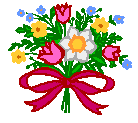Superstition: The lore and symbolism of the bridal bouquet.
Origins: Flowers

are pretty, and they are a lovely accessory for any woman to carry at any time. A bouquet of them ends up in the hands of the bride, however, for other reasons.
The bouquet she carries is a symbol of sexuality and fertility. Easily-broken blossoms signify the same characteristics inherent to a woman's virginity. Flowers also testify to fruit-bearing properties and thus represent an emblem of pregnancy
promised.
Some flowers are more favored for incorporation into bridal bouquets than others. White flowers alone are traditionally eschewed because of associations between them and death; if white blooms are used, they must be mixed with other colors. But not red (or at least not unaccompanied red). No caution-minded bride thinks of carrying a bouquet made up solely of red and white flowers; that floral combination is a harbinger of
death.
The marigold is commonly included in bridal bouquets because its bloom faithfully follows the sun, opening its petals in the sunlight but closing them once the light has gone. This behavior has elevated it to a symbol of constancy and endurance of love.
Early bridal bouquets were often composed of herbs, not flowers. Dill was especially popular, and the bridal dill was served up at the wedding feast to provoke lust. In 16th century England, marigolds (an edible flower) were carried for the same reason.
These days the bride tosses her bouquet away as a way of discerning whom Fate has next selected from all the unmarried females present to be the next bride. Customarily, the bride turns her back on the assembled maidens and flings her bouquet over her shoulder without looking, thus leaving Fate a free hand. (Modern custom now sometimes sees the groom throwing his wife's garter to his unwed groomsmen for the same purpose.)
Catching the bridal bouquet wasn't the only way to determine who was next selected for matrimony; undressing the bride on her wedding night provided the bridesmaids with another opportunity. Whoever was the first to draw one of the bride's pins was said to be next to the altar. Bridal pins, however, could not be kept; they had to be disposed of once they'd served their one and only purpose of holding things fast on that key day. To leave a pin on the bride would bring her ill fortune, so she had to be checked over very carefully.
If the bride (or her principal bridesmaid) stands at the head of the staircase and tosses the right bridal shoe into the crowd of guests assembled at its base, the one who catches it will be the next to marry.
Barbara "flower girlish" Mikkelson
Last updated: 27 June 2005
 Sources:
Sources:

